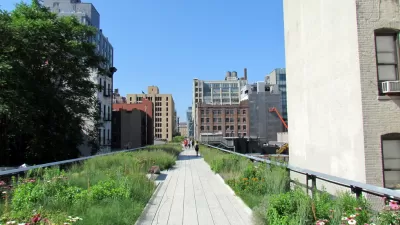Planning
To Create a Great 'Third Place', Get Out of the Way
For far too long, the shaping of public spaces has been left to architects and urban planners, who plan from the top down. The most successful projects involve people directly in deciding how their public spaces will look, feel, and operate.
Examining L.A.'s Dirty Zoning Secrets
To celebrate its 50th post, Jeremy Rosenberg has handed over the reins of his "Laws That Shape L.A." column. The focus of this week's guest feature: the special overlays and site-specific designations that cover 60 percent of the city's geography.
Placemaking vs. Placeshaking: Planning & Politics
Are you a Place-Maker or a Place-Shaker? Check out Scott Doyon's post for a look at where to draw the line. Spoiler alert: It's all about the politics.
Schools: Planning's Enduring Blindspot
Schools are a prime driver of housing choices and transportation behavior. So why are schools and children often missing from the planning process? Ruth Miller diagnoses the problem and looks at how we can change it.
Valentines for City Enthusiasts
If you're looking for the perfect Valentine's Day card for the planning enthusiast in your life, search no further. Five different Valentines show appreciation for cities and the people that live in them.
Internships: An Invaluable Resource During Tight Budgets
Michael A. Harper, FAICP worked over 32 years as a public sector planning manager. During that time, he used paid and unpaid interns extensively. Harper's article focuses on the many ways to effectively engage interns and use their talents.

Landscape Architects Step Into Vacuum Left by Planners and Architects
Landscape Architecture is a field in the ascendency, writes Alan G. Brake. Its rise can be traced to the inability of Architects and Planners to engage with some of the most important challenges of our time.
Getting the Best Results out of Planned Unit Developments
Bob Bengford, AICP, MAKERS, takes a look at how planned unit development (PUD) ordinances are working in several Northwest communities, the major issues and challenges, and whether PUD ordinances are even necessary.
Urban Planning Trends are Bad Medicine
In a provocative essay, Mitchell Sutika Sipus examines the dangers of subscribing to conventions such as style or planning trends, and argues why planners must forgo ideologies to create better solutions for community problems.
New Initiative Brings 3D Planning to the Public
Eric Jaffe writes on a new interactive planning initiative in Louisville, Kentucky, that takes a hands-on approach to public engagement.
Study Shows Smart Growth Reduces Automobile Usage
A new study shows that denser, more transit-oriented development will lead to an overall decrease in miles driven, reports Angie Schmitt.
Oslo Plans for an Intercultural Future
Oslo's once-homogenous population has changed dramatically in the past few decades: immigrants and their descendants are predicted to account for 50% of all residents by 2030. Sarah Wesseler looks at the spatial implications of this transition.
Avoiding Logical Fallacies in Planning
Our profession relies on logical analysis of accurate data. There are an amazing number of ways to go wrong.
Reinventing Los Angeles: Seizing the Transit Opportunity
Ken Bernstein, Principal Planner for the City of L.A., explores how the expansion of transit in Los Angeles is changing how the department approaches its plans and the planning process.
Planners Must Speak for the Disadvantaged
"No one other than we as planners has the responsibility for decisions today that will profoundly affect others," says Attorney/Planner Dwight H. Merriam.
Where the Hipsters Go
Good planning is attracting young hipsters to cities throughout the world, writes Christopher F. Schuetze.
Critics Argue Against Public Participation
Public participation is an important part of the urban planning process, says Michael Hooper, as "it improves project outcomes and the likelihood of project success." But lately, some prominent people are saying that it hinders the planning process.
Austin Releases An All Encompassing New 30 Year Plan
The city of Austin has released a new 197 page planning document to manage its population growth and inform planning decisions for the next three decades.
Can a 'Case Management' Office Save the Development Process in Los Angeles?
Despite 40 percent fewer employees, the department recently announced a reform plan to expedite the development approval process by bringing the city's Planning Department and the Department of Building and Safety under one roof.
Pagination
Urban Design for Planners 1: Software Tools
This six-course series explores essential urban design concepts using open source software and equips planners with the tools they need to participate fully in the urban design process.
Planning for Universal Design
Learn the tools for implementing Universal Design in planning regulations.
Heyer Gruel & Associates PA
City of Moreno Valley
Institute for Housing and Urban Development Studies (IHS)
City of Grandview
Harvard GSD Executive Education
Salt Lake City
NYU Wagner Graduate School of Public Service
City of Cambridge, Maryland


































